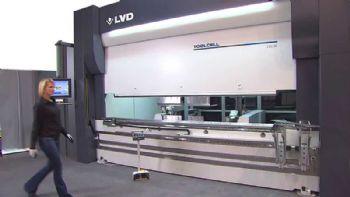
Banbury-based LVD Pullmax Ltd (
www.lvdgroup.com) has expanded its range of ToolCell automated tool-changing press brakes with the ToolCell 220/30 Plus and ToolCell 220/40 Plus.
These new Plus models can handle bend lengths of 3 and 4m respectively, and deliver 220 tonnes of bending force. Both feature an opening of 570mm (with a stroke of 300mm) to accommodate tools capable of producing high flanges.
If required, this can be enhanced to an opening of 670mm and a stroke of 400mm. LVD’s ToolCell hydraulic press brake features an integrated tool changer and tool-storage system that allows the machine to automatically select and place the tooling required for the job. While the operator is preparing parts for the next job, the machine unloads the previous tooling and loads the next set-up, all without manual intervention.
Meanwhile, the accuracy of bending operations is said to be assured by LVD’s patented Easy-Form Laser adaptive-bending system, which is standard on all ToolCell models. Easy-Form Laser provides in-process angle monitoring via laser scanners located on the front and back of the press brake table.
The system transmits information in real time to the CNC, which adjusts parameters accordingly to ensure the correct angle. No production time is lost, as the bending process is not interrupted.
Using Easy-Form Laser, the machine can adapt to material variations such as sheet thickness, strain hardening and grain direction, automatically compensating for any changes.
ToolCell press brakes are Industry 4.0-ready thanks to LVD’s latest-generation Touch-B control, which is linked to a central CADMAN database where all production-relevant data is stored. Communication to management, planning, production, quotation, costing and other external software modules is handled via a standardised open interface.